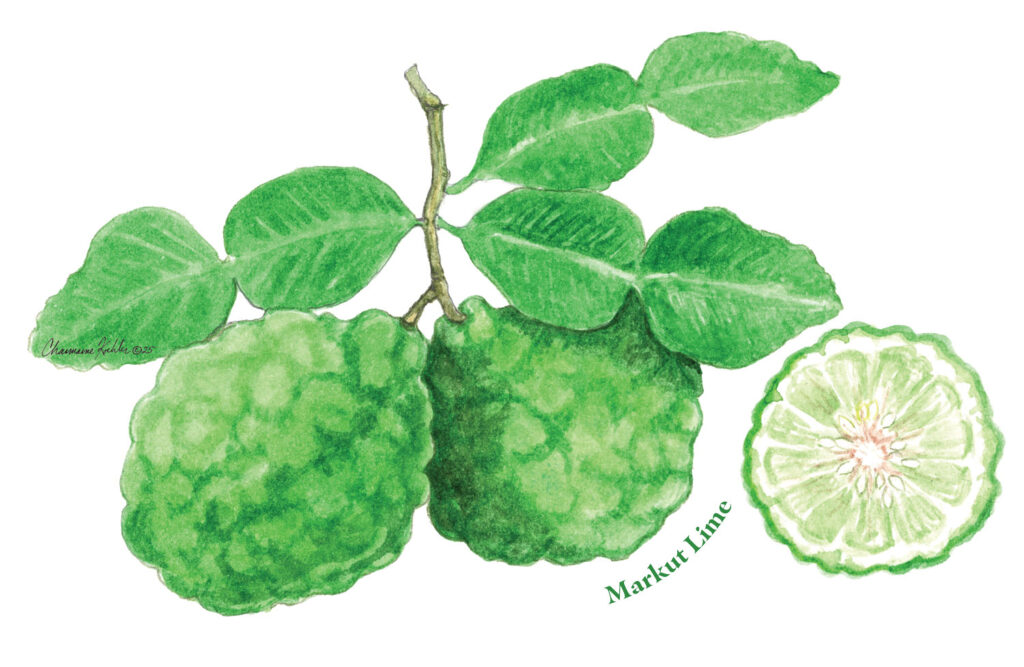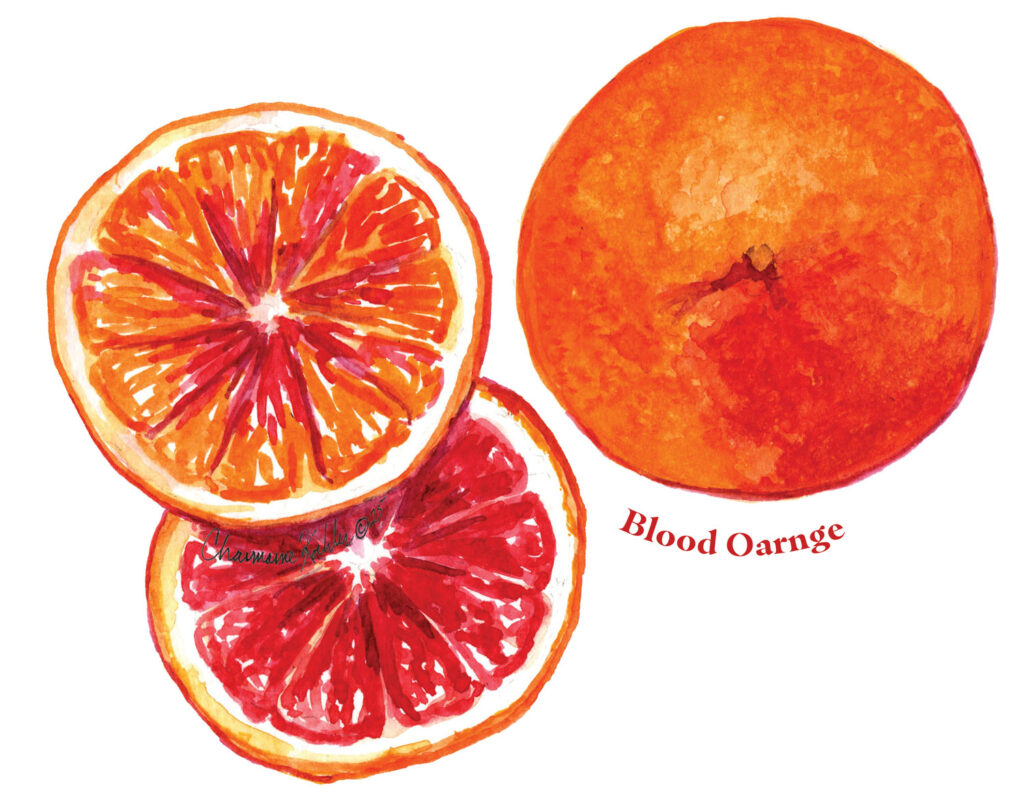In Season: Citrus Standouts
By Barbara Kobsar | Illustrations by Charmaine Koehler-Lodge
 While deciduous fruit trees—like apples, pears, and peaches—are getting their requisite “chill hours” through our California winter, the non-deciduous subtropical citrus trees are producing a gorgeous spectrum of gem-like fruits. Your local farmers’ market is the perfect place to explore a myriad of citrus varieties.
While deciduous fruit trees—like apples, pears, and peaches—are getting their requisite “chill hours” through our California winter, the non-deciduous subtropical citrus trees are producing a gorgeous spectrum of gem-like fruits. Your local farmers’ market is the perfect place to explore a myriad of citrus varieties.
It’s always fun to pick up a pomelo, one of the four ancestral citrus fruits. (The others are papeda, mandarin, and citron.) Ancestor to the grapefruit, this typically very large fruit has a thick skin and is less bitter than its hybridized descendant.
I always look forward to the winter arrival of the blood orange, which brings flair and flavor to the Cottage Kitchen jams and jellies I make and sell at market. In addition to its deep-red color, it brings pleasing notes of raspberry. I’ll combine its juice with other citrus juices to make a glaze for chicken or fish.
 Navel oranges are the dominant “squeeze” in the market, but the Cara Cara—a navel orange mutation—is adored for its pinkish-red flesh, low acidity, and sweet berry-like flavor notes.
Navel oranges are the dominant “squeeze” in the market, but the Cara Cara—a navel orange mutation—is adored for its pinkish-red flesh, low acidity, and sweet berry-like flavor notes.
The mandarins and their many hybrids always draw crowds at market. Depending on variety, they might be sweet or tart, large or small, seedless or seeded, but everyone loves how their loose-fitting skins and easy-to-separate segments make them convenient to eat. They are especially popular during Lunar New Year, when they serve as symbols of good luck and abundance (especially when they have a stem and leaves attached). Native to China, mandarin oranges might have been named after the bright-orange robes worn by some mandarins, the public officials of the Chinese Empire.
The tangerine is a mandarin/bitter orange hybrid. Favorites are the tiny Clementine and seedless sweet Satsuma. The popular Fairchild tangerine is actually a Clementine/tangelo hybrid, while the tangelo itself is a tangerine/grapefruit hybrid. I especially like the juicy Minneola tangelo, which is easy to spot with its pebbly skin, deep red-orange color, and round bump at its stem end. The tangor is a tangerine/sweet orange cross. Frequently called temple orange or royal mandarin, it has what some call a “spicy” flavor.
Cooks looking for East Asian flavors enjoy finding the seedy yuzu at market. A cross of a mandarin with the Chinese orange known as papeda, it has delicate floral aromas and flavors of lemon and grapefruit with hints of lime. At the Saturday San Ramon Farmers’ Market, I’ll visit Tim Deasy at K & J Orchards and Jay Yoon at GreenFriends Farm when I want some yuzu juice and zest to add a special zing to drinks, marinades, dressings, and teas.
The makrut lime, with its wrinkled green skin, is dry and bitter, but its uniquely double-lobed and intensely flavored leaves are a key ingredient in many Southeast Asian curries and stews. Twist the leaves to release the aromatic oils, then tear into large pieces and add to the dish.
Kumquat lovers should keep an eye open for the calamansi, a kumquat/mandarin hybrid that resembles a round lime or very small orange. It offers a bright, tart flavor and a strong floral scent. In traditional Filipino cooking, it’s as common as a lemon or lime is in the U.S. The peel is edible—like a kumquat’s—and is usually sweeter than the fruit itself. ♦


Lemon & Tangerine Curd
Curds add a tangy, creamy touch to fresh fruit, trifles, crepes, and other baked goods. Try it with the scones from Westport Hotel.
Makes about 3 cups
- ½ cup butter
- 1 cup sugar
- ½ cup fresh-squeezed tangerine juice
- ¼ cup fresh-squeezed lemon juice
- 4 eggs, whisked
Melt butter in top of double boiler. Stir in sugar and juices. Whisk in eggs. Cook over gently boiling water, whisking often, until mixture reaches 170–180° (or until it thickens and coats the back of a spoon), 7–8 minutes. Allow to cool before using. Store in a container with a lid in the refrigerator for up to 3 weeks.
Veteran journalist and cookbook author Barbara Kobsar focuses on traditional home-cooked meals using local produce. Find her at the Walnut Creek and San Ramon farmers’ markets selling her Cottage Kitchen jams and jellies.
Artist Charmaine Koehler-Lodge grows most of her family’s food in their large home garden.

